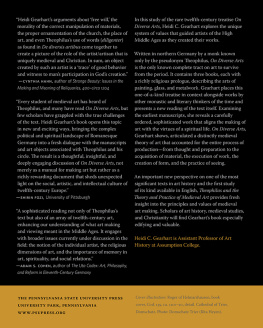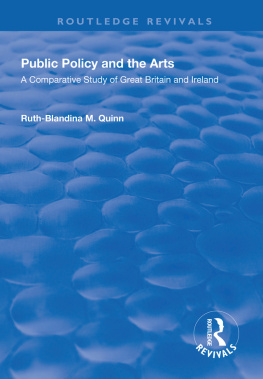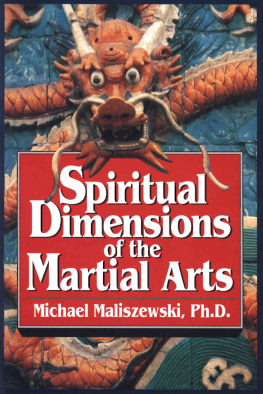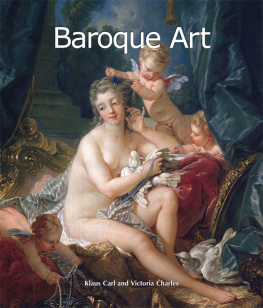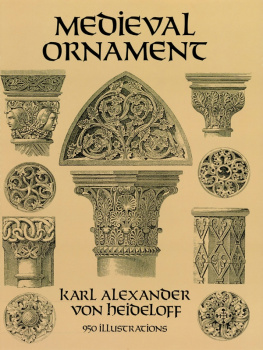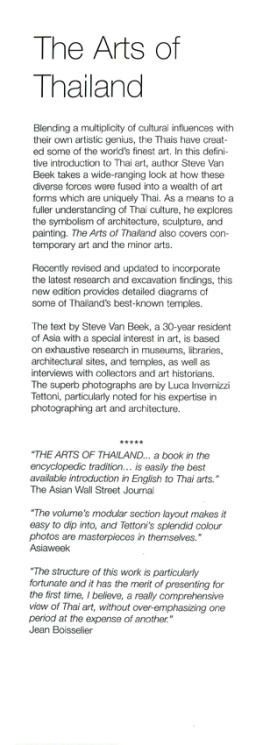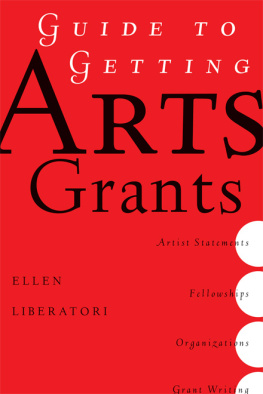THEOPHILUS AND THE THEORY AND
PRACTICE OF MEDIEVAL ART
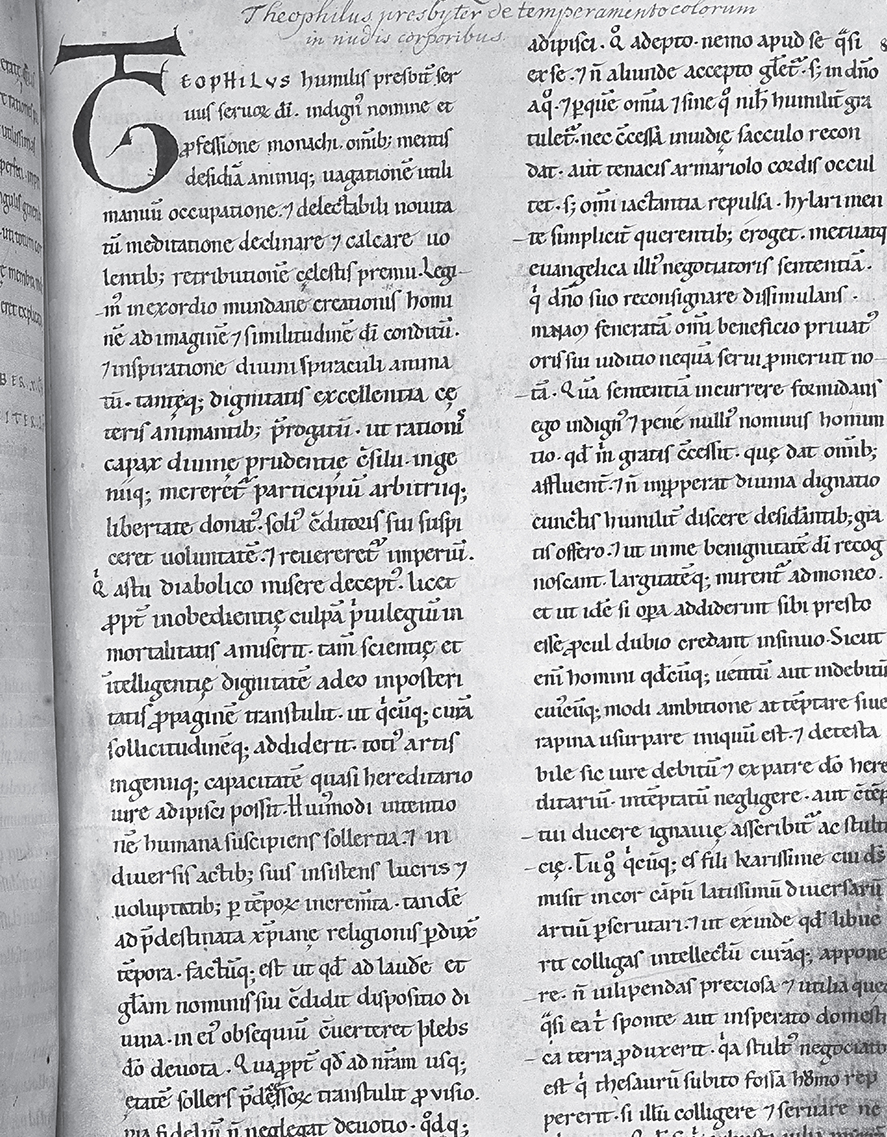
THEOPHILUS AND THE
THEORY AND PRACTICE OF
MEDIEVAL ART
Heidi C. Gearhart |
The Pennsylvania State University Press
University Park, Pennsylvania |
Publication of this book has been supported by a Samuel H. Kress Foundation Research Grant administered by the International Center of Medieval Art.
Library of Congress Cataloging-in-Publication Data
Names: Gearhart, Heidi C., 1976 , author.
Title: Theophilus and the theory and practice of medieval art / Heidi C. Gearhart.
Description: University Park, Pennsylvania : The Pennsylvania State University Press, [2017] | Includes bibliographical references and index.
Summary: Explores Theophilus On Diverse Arts, a twelfth-century treatise on artistic techniques. Examines the system of values according to which medieval artists operated and created art objectsProvided by publisher.
Identifiers: LCCN 2016037480 | ISBN 9780271077154 (cloth : alk. paper)
Subjects: LCSH: Theophilus, Presbyter, active 12th century. De diversis artibus. | ArtEarly works to 1800. | ArtTechniqueEarly works to 1800. | Art, Medieval.
Classification: LCC N7420 .G43 2017 | DDC 709.02dc23
LC record available at https://lccn.loc.gov/2016037480
Copyright 2017 The Pennsylvania State University
All rights reserved
Printed in China
Published by The Pennsylvania State University Press,
University Park, PA 168021003
The Pennsylvania State University Press is a member of the Association of American University Presses.
It is the policy of The Pennsylvania State University Press to use acid-free paper. Publications on uncoated stock satisfy the minimum requirements of American National Standard for Information SciencesPermanence of Paper for Printed Library Material, ANSI Z 39.481992.
Frontispiece: Incipit Theophilus, De diversis artibus, mid-twelfth century. Wolfenbttel, Herzog-August Bibliothek Cod. Guelph Gudianus lat. 269, fol. 86r. Photo: Herzog-August Bibliotek Wolfenbttel.
For my parents
CONTENTS
PLATES
FIGURES
MAP
I have been thinking about artists in the Romanesque period and about Theophiluss treatise On Diverse Arts for quite some time now. Perhaps what has struck me most is how much this text has to offer and how very rich it is. It is my hope that this book will be part of a larger conversation and something upon which to build. Many people and institutions have supported this project along the way, and to them I extend my gratitude.
A large portion of this book was written over the course of a fellowship year at the Getty Research Institute. Special thanks go to Thomas Gaehtgens, Alexa Sekyra, and the staff in the GRI as well as to Beth Morrison, Thomas Kren, and the manuscripts department. I owe much to Ulrike Kern, Sarah Lepinski, Thomas Kirchner, Joanna Cannon, and my other fellow Getty scholars for their insights, conversation, and for broadening my idea of what artistic practice could be. Special thanks must go to Hiltrud Westermann-Angerhausen, who kindly shared her expertise on Theophilus and ars sacra and whose breadth of knowledge and graciousness have been an inspiration.
Further financial assistance for research came from the Belgian American Educational Foundation, the Kress Foundation, the University of Michigan, and Assumption College. A publication grant from the International Center for Medieval Art and the Kress Foundation, and funds from the Provosts Office of Assumption College, made the production of this book possible. I am thankful for this support.
The manuscripts of On Diverse Arts are spread across Europe, and I am grateful to the staff at the libraries that hold them for their assistance in my research and in providing images for this volume. Special thanks go to Christian Heitzmann, Michaela Weber, and Claudia Minners-Knaup at the Herzog-August Bibliothek in Wolfenbttel; Andreas Fingernagel, Peter Prokop, and Marlies Dornig at the sterreichische Nationalbibliothek in Vienna; Elaine Pordes, Chris Rawlings, and Jovita Callueng at the British Library, London; and Jayne Ringrose and Grant Young at the University Library, Cambridge. Special thanks are also due to Lothar Lombacher at the Kunstgewerbemuseum, Berlin; Ansgar Hoffmann at the Dizesanmuseum, Paderborn; the Schntgen Museum and the Rheinisches Bildarchiv, Cologne; Ute Kunz at the Museum Angewandte Kunst, Frankfurt; Elizabeth Saluk at the Cleveland Museum of Art; Andrea Wegener at the Domschatz, Essen; the Ghent University Library; the Morgan Library and Museum, New York; the Mnster Staatsarchiv; the Dizesanmuseum, Osnabrck; the Paderborn Erzbistumsarchiv; the Muses de Strasbourg; Kirstin Mannhardt at the Museum am Dom, Trier; the Kunsthistorisches Museum, Vienna; the Koninklijke Musea voor Kunst en Geschiedenis / Muses royaux dArt et dHistoire, Brussels; the Hauptstaatsarchiv, Stuttgart; and the Domschatzkammer, Aachen.
I would also like to thank Pascal Trousse and Thierry Dewin at the Royal Library in Brussels; Christoph Mackert at the Universitaetsbibliothek, Leipzig; Pierre-Jean Riamond at the Bibliothque nationale de France, Paris; Giuseppe Ciminello at the Vatican Library, Rome; Barbara Denis at the Bibliothque municipale dAvranches; Michal Broda at the Wrocaw University Library; Sally Speirs and Christine Ferdinand at Magdalene College, Oxford; Julian Reid at Corpus Christi College, Oxford; Tricia Boyd at the Edinburgh University Library; Susy Marcon at the Biblioteca Nazionale Marciana, Venice; Rosella Pecchioli in the Biblioteca Nazionale Centrale, Florence; Wolfgang-Valentin Ikas at the Bayerische Staatsbibliothek, Munich; Heinz Ristory at the Stiftsbibliothek, Klosterneuburg; Mireille Vial at the Bibliothque interuniversitaire section mdecine, cole de Mdecine, Montpellier; and the staff at the Rakow Research Library, Corning Museum of Glass, in Corning, New York. My knowledge and study of the Theophilus manuscripts are greatly indebted to them.
For additional assistance in research I must thank the staff of the Zentralinstitut fr Kunstgeschichte and the Bayerischestaatsbibliothek, Munich; the Fine Arts Library at Harvard University; the Warburg Institute, London; the Boston Athenaeum; and especially Vivienne Anthony at Assumption College, whose patience, kindness, and ability to track down all kinds of requests have been invaluable.
My deepest gratitude goes to my mentor at the University of Michigan, Elizabeth Sears, who first introduced me to Theophilus and to the rigors and joys of studying the twelfth century. She has given me much in guidance, time, and expertise. Without her understanding of the field, her patience and generosity, and her gift of counsel, as Theophilus and Augustine might put it, this book would not be. My scholarship is indebted to her. I am also grateful to Megan Holmes, Achim Timmermann, Helmut Puff, Pat Simons, Sussan Babaie, Celeste Brusati, Alex Potts, and Margaret Cool Root at the University of Michigan for their knowledge, their support, their probing questions, and their insights.
This book benefited immeasurably from conversations with scholars and colleagues in Europe, the United States, and Australia. I am especially grateful to Barbara Baert at the Katholieke Universiteit, Leuven; Christian Heck and John Lowden and the Leuven-Lille-London manuscripts group; Wolfgang Augustyn and Iris Lauterbach at the Zentralinstitut fr Kunstgeschichte, Munich; and Avinoam Shalem at the Ludwig-Maximilians-Universitt, Munich. Conversations with Peter Barnet and Pete Dandridge at the Metropolitan Museum of Art on the technical aspects of

